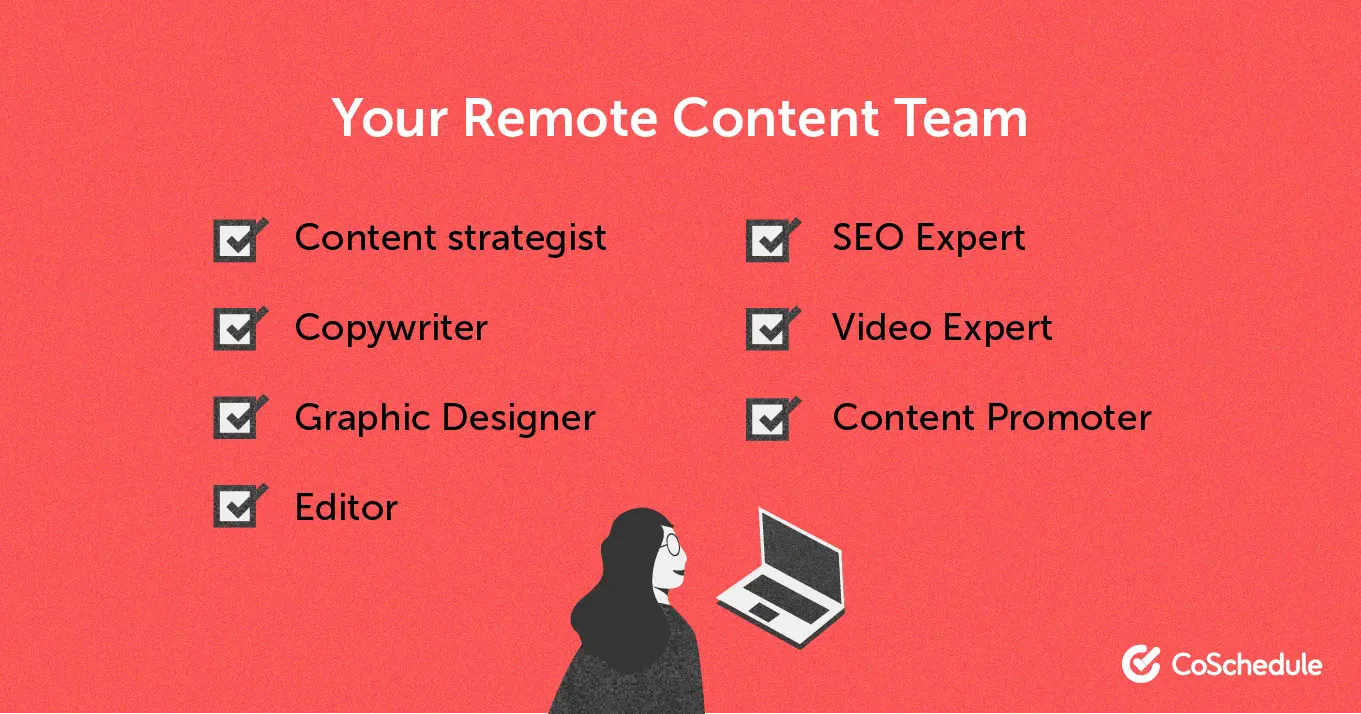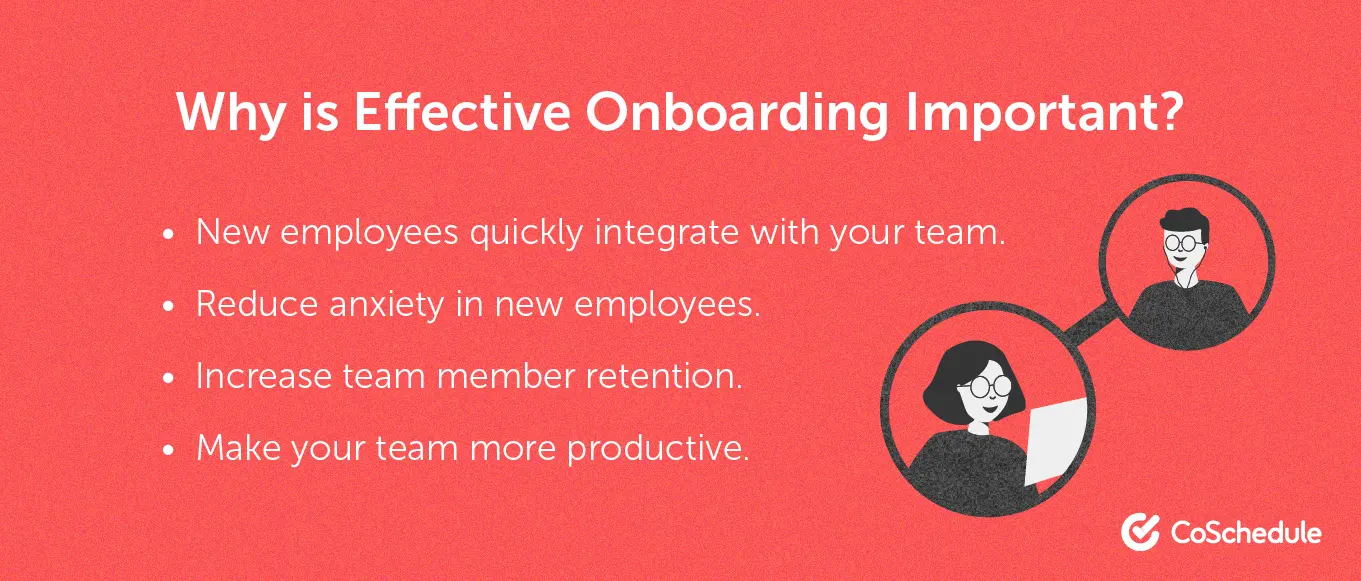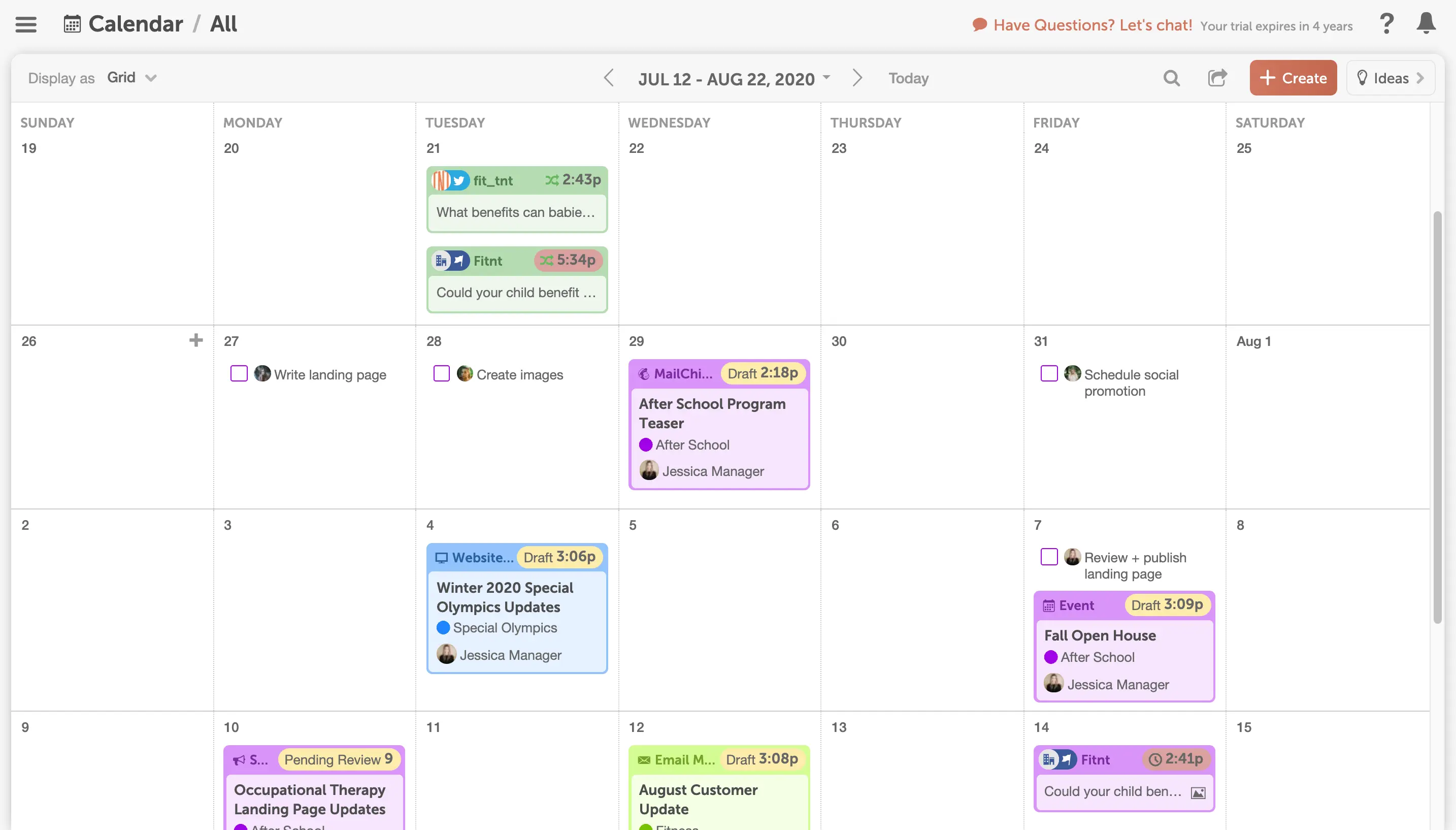How to Build a Remote Content Marketing Team That Produces Results
Download Your Own Marketing Calendar Template
Half the battle to creating your own marketing calendar is having a good grasp on what you need to include. Use this template to help guide you through the process of getting a handle on how you should plan your marketing strategy. Alright, enough chit-chat. Let's dive in!Provide Your Content Strategy and Other Documentation
The first step in building your remote content marketing team is putting all resources in place for your team. This will help to produce content right off the bat. The most important of these resources is your content strategy. Your content strategy helps you define why you’re creating content, who you’re creating it for, what type of content you’ll be creating, and what your content marketing goals are.Before you start looking for writers, you need to create an effective content strategy that will help you decide on the type and number of writers you need to hire. The strategy will also help you stay focused on your long-term goals, and not just on producing content. – Jill Phillips, Buildfire
 In addition to your content strategy, here are other crucial resources for your content marketing team:
In addition to your content strategy, here are other crucial resources for your content marketing team:
- Style guides
- Writing guidelines
- Content checklists
- SEO checklists
- Process checklists
Put These Resources Together First
Consider these resources as your battle plan and your team members as the soldiers. You’ll want to get all your tools, plans, maps, and strategies in place before your soldiers march. These documents will:- Help your team crank up high-quality and relevant content like clockwork.
- Ensure your content effort is directed towards achieving your company’s overall marketing and business goals.
- Confirm content is created in a consistent manner across all team members.
How to Create These Resources for Your Team
This CoSchedule’s complete guide to building and executing your own content marketing strategy is a great place to start.Before you start looking for writers, you need to create an effective content strategy that will help you decide on the type and number of writers you need to hire - Jill Phillips, Buildfire
Click To TweetHire Your Content Team
You’ll need talent and humans to achieve your content marketing goals.You need a village to create effective content – Gerrad Huiz, Adobe.The success of your remote content marketing team depends on who you hire, and hiring is not a stroll through the park. It takes a lot of investment in time and resources. According to entrepreneur.com, small business owners spend around 40% of their working hours on tasks that do not generate income — such as taking the time to hire.
Who Are the Must-have Team Members?
I asked Kevin Indig, VP of Content and SEO at G2, who the must-have team members of any content marketing team are.It depends on the company's business model and market, but very broadly, I would say the editor. Editors have a huge impact on the tone of voice, content quality, and often SEO. I've seen editors taking on SEO reviews many times. They are like a bottleneck for quality, in a good sense. – Kevin Indig, G2In addition to an editor, here are other must-have members for any successful content marketing team.
- Content strategists
- Copywriters/content writers
- Graphic designers
- Videographers
- SEO experts
- Content promoters
 How many people you hire depends on your budget and content strategy.
Sara Pion, Brand Content Manager at Alyce, gives this crucial advice to anyone building a remote content marketing team.
How many people you hire depends on your budget and content strategy.
Sara Pion, Brand Content Manager at Alyce, gives this crucial advice to anyone building a remote content marketing team.
I think content marketing teams shouldn't just have writers. Content marketing comes in the form of video, audio, design, AND written words, as well as the post-creation distribution. But you shouldn't start with every single one of those forms of content. Then you'll bite off way more than you can chew. Find one or two channels to start in that you can master and hire people who can make those channels best-in-class.If you’re just starting with your team, I’ll recommend you start with hiring freelancers. Hiring full-time employees right away eliminates the flexibility you need to determine the skills your team demands. Hiring freelancers will help you scale up/down based on your needs.
How to Hire for Your Remote Team
It’s not just enough to know you need experts on your team; you need to know who your team needs at the moment. Who do you hire for your team? Follow these simple steps to determine who to hire.- List out the skills you need to create the kind of content you want to create from your content strategy.
- List out the job roles that provide these skills.
- SEO
- Writing
- Visual design
- Editing
Hiring Tools
Here are some tools to help you recruit for your remote content marketing team.- Career page
- Job posts and ads on social media
- Hiring from third-party marketplaces (e.g. Upwork and Fiverr)
- Outsourcing to job posting platforms (e.g. Glassdoor or LinkedIn)
- Hiring directly from your LinkedIn connection
When hiring for your remote content marketing team, do not fall for the temptation to employ cheap labor.
Click To TweetCarry Out Effective Onboarding
Hiring the best is not enough; the success of your remote content marketing team depends on the effectiveness of your onboarding process. For your new employees to function productively, you need an effective onboarding structure/process. Effective onboarding helps you get the new team members up to speed with your marketing goals and strategy, their job responsibilities, tools, and how you go about creating content.Why is Effective Onboarding Important?
A well structured and executed onboarding process helps:- New employees quickly integrate with your team.
- Reduce anxiety in new employees.
- Increase team member retention.
- Make your team more productive.

How to Carry Out Effective Onboarding
Darren Murph, of >GitLab, gives two crucial points for an effective onboarding process.- Establish an onboarding, buddy system.
- Empower your new hires to grab ten coffee chats with people across the company.
- Get on a video call to establish a face-to-face relationship with new employees.
- Take the new employee through a tour of your company/team.
- Introduce them to the tools you use and give them access, so they can start getting familiar.
- Share all the documentation and resources from Step One with your new employees.
- Introduce them to the team as early as possible.
- Get the employee started immediately with their first task.
Tools to Help You Onboard Effectively
Onboarding does not need to be all manual. An onboarding checklist could help make the process smooth and consistent. There are also software tools that help automate onboarding processes. Here are our top picks.Set Up Team Management Structures
Practical team management helps ensure tasks are not delayed, deadlines are met, and goals are achieved. Doing this for a traditional in-house team is demanding, but more demanding for a remote team.Why Effective Team Management is Important
Your remote team will consist of members from different cultures, time zones, expertise, and backgrounds. You must get all of them to work together to achieve your goals. For a remote content marketing team, the following scenarios are common.- Violated deadlines
- Incomplete task
- Low-quality work
Manage Your Remote Team Effectively
The first step to managing your team is having a well organized and laid out sequence of tasks on all the projects your team will be working on for a period of time. This involves proper scheduling, assigning, tracking, and reporting. Here is how you can do this.
Here is how you can do this.
- Plan all your tasks at least one month ahead.
- Assign each task to the responsible team member.
- Provide all the information and resources to get the job done.
- Provide clear performance measurement criteria for each team member.
- Keep track of progress on each task to ensure quality and timeline are on track.
- Give and pull for feedback on tasks to ensure all roadblocks are removed, and the work is completed.
- Keep an open line of communication with your team members.
Keep track of work progress and maintain communication.
Click To TweetBest Team Management Tools
There are a lot of tools available to help you manage your team, but it is not enough to pick up any software tool you find. Here are things to look out for when choosing a team management tool for your organization. The tool must help you:- Add your team members
- Schedule tasks
- Assign tasks to different team members
- Track work progress and timeline
- Give and obtain feedback seamlessly while working on the project

Develop a Culture of Documentation
Documenting all your work processes and flow is a great way to harmonize work in a remote team, build consistency, and increase the quality of work produced. Proper documentation also helps to ensure nobody becomes an information bottleneck in your team. For your team members and new employees, a host of resources to fall back to when is a delight. Document all processes in your team to create a knowledge base, and invite your team members to add to the knowledge base.Effectively Document in Your Remote Content Marketing Team
- Start with instilling the importance of documentation on each of your team members.
- Get them to see why documenting their processes will help the team produce results, fast.
- Create a structure or template that your team members can just copy and use anytime.
- Store this documentation online for quick and easy access.
- You can use Google Drive or Dropbox for this. Create a folder for documentation, and invite your team members to contribute.
- Add documentation to the daily task of your team members.
Build and Enable Effective Communication
Effective communication is one of the challenges remote teams face. Things can quickly go south, if your team members do not stay in touch. There isn't an office to stop by or water-cooler chats for a remote team. For your remote team to succeed, you must figure out a way to communicate like you’re in a physical office just down the road. Poor communication leads to:- Low-quality work
- Low employee satisfaction
- The feeling of not belonging
Boost Communication in Your Remote Team
 Here are some tips you can use to set communication on track for your business:
Here are some tips you can use to set communication on track for your business:
- Organize team meetings at least once a week. These are called "standup meetings" in the tech world. The purpose of the meeting is to discuss work, progress challenges, and the way forward. While doing this, be sure to consider the timezone for every team member.
- Establish a clear line of communication and reporting. Everyone must know who to report to and how.
- Encourage team members to reach out to one another — just to hangout. This is the fastest way to bond.
- Once a month or every quarter, organize a team hangout where all you do is talk about one another (no work).
- If the funds are available, organize a physical meeting once in a year.
- Invest in communication tools.
Tools for Effective Communication
There are a ton of tools that can help keep your team in touch. Of all the tools, Slack is the best I’ve seen. Slack comes with text, audio, and video chat features. There is also the channel feature that allows you to create subgroups for team- and project-based conversations. Here are some tips to help you use Slack more effectively:
Here are some tips to help you use Slack more effectively:
- Create channels for each team.
- Create channels for each project.
- Integrate all your work tools (like CoSchedule, Google docs, etc.) on Slack, so you can work and communicate from one place.
- Conversations should be made on threads to streamline engagement.
- Spice up your Slack with some fun integrations, like the Icebreakers Integration.
- Zoom
- Google Meet
- Microsoft Team
- Good ol' email
- Phone calls
Make sure your team is onboard with the communication tools you decide to utilize within your work space.
Click To TweetSome Content Optimization Tools
A lot of your content will be text-based. They may be blog posts, pillar pages, emails, ebooks, webinar scripts, video scripts, etc. Here are some handy tools to help with content creation.- CoSchedule Headline and Email Subject Line Analyzer, for writing converting headlines and email subject lines.
- Hemingway app, to check for content readability.
- Grammarly, for proofreading and error checking.
- Yoast SEO analyzer (on-page SEO optimization)
- UberSuggest
- SEMRush, for keyword and topic research.
Team Security Best Practices
Your team will be 100% online. Here are some tips to help your build and run a secure virtual workspace:- Create corporate emails for every team member, so you can restrict access to your domain.
- Login to sensitive data via a VPS.
- Change all shared passwords when any team member leaves.
- Use a SaaS management tool, like Blissfully and Torii, to streamline and manage your online tool usage.
Content Marketing Team Management Best Practices
There is no one-size-fits-all guide to managing remote teams; your team is unique, and so is how you’ll handle them. Here are some team management best practices:- Do not micromanage your team. Give everyone the space to work in their own pace and style, while ensuring deadlines and quality are not violated.
- Take documentation seriously.
- Ensure communication is a core culture
- Reward good work and learn to understand you team members
Conclusion
A quick recap of what we discussed.- Start with putting your resources together and setting team goals.
- Hire and onboard, like team’s success depends on it.
- Manage your team with tools, like CoSchedule.
- Keep the channel of communication open.



